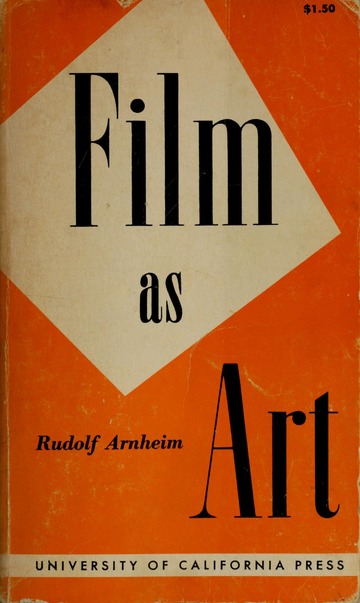Rudolf Arnheim: Film as Art (1932/1957)
Filed under book | Tags: · chronophotography, cinema, film, film sound, film theory, montage, photography, silent cinema

“This is a book of standards, a theory of film. The greater part of it is an adaptation of “Film als Kunst,” first published in 1932 in the original German and in English by Faber and Faber in 1933 – an edition long out of print but still in demand because it raises fundamental questions that the intervening years have by no means answered. This edition expands the original translation by four essays.”
Originally published as Film als Kunst by Ernst Rowohlt, Berlin, 1932.
Publisher University of California Press, 1957
ISBN 0520000358, 9780520000353
230 pages
Richard Abel, Rick Altman (eds.): The Sounds of Early Cinema (2001)
Filed under book | Tags: · cinema, film, film history, music, silent cinema, sound recording, theatre

The first book to examine the variety of sounds that accompanied so-called silent cinema.
The Sounds of Early Cinema is devoted exclusively to a little-known, yet absolutely crucial phenomenon: the ubiquitous presence of sound in early cinema. “Silent cinema” may rarely have been silent, but the sheer diversity of sound(s) and sound/image relations characterizing the first 20 years of moving picture exhibition can still astonish us. Whether instrumental, vocal, or mechanical, sound ranged from the improvised to the pre-arranged (as in scripts, scores, and cue sheets). The practice of mixing sounds with images differed widely, depending on the venue (the nickelodeon in Chicago versus the summer Chautauqua in rural Iowa, the music hall in London or Paris versus the newest palace cinema in New York City) as well as on the historical moment (a single venue might change radically, and many times, from 1906 to 1910).
Contributors include Richard Abel, Rick Altman, Edouard Arnoldy, Mats Björkin, Stephen Bottomore, Marta Braun, Jean Châteauvert, Ian Christie, Richard Crangle, Helen Day-Mayer, John Fullerton, Jane Gaines, André Gaudreault, Tom Gunning, François Jost, Charlie Keil, Jeff Klenotic, Germain Lacasse, Neil Lerner, Patrick Loughney, David Mayer, Domi-nique Nasta, Bernard Perron, Jacques Polet, Lauren Rabinovitz, Isabelle Raynauld, Herbert Reynolds, Gregory A. Waller, and Rashit M. Yangirov.
Richard Abel is Ellis and Nell Levitt Professor of English at Drake University, where he teaches cinema/media/cultural studies. His most recent book is The Red Rooster Scare: Making Cinema American, 1900-1910 (California, 1999), which was a finalist for the Kraszna-Krausz Moving Image Book Award. Currently he is editing the Routledge Encyclopedia of Early Cinema.
Rick Altman is Professor of Cinema and Comparative Literature at the University of Iowa. After publishing Film/Genre (British Film Institute, 1999), which won the SCS Katherine Singer Kovacs award, he edited a special issue of IRIS 27 (Spring 1999) on the “State of Sound Studies.” His current projects include a book on the silent cinema soundscape, a DVD devoted to illustrated song slides, and performances by his troupe, The Living Nickelodeon.
Publisher Indiana University Press, 2001
ISBN 0253214793, 9780253214799
327 pages
More info (publisher)
More info (google books)
PDF (updated on 2012-7-14)
Comment (0)Frances Guerin: A Culture of Light: Cinema and Technology in 1920s Germany (2005)
Filed under book | Tags: · 1920s, cinema, film, film history, germany, silent cinema, technology, weimar republic

Cinema is a medium of light. And during Weimar Germany’s advance to technological modernity, light – particularly the representational possibilities of electrical light – became the link between the cinema screen and the rapid changes that were transforming German life.
In Frances Guerin’s compelling history of German silent cinema of the 1920s, the innovative use of light is the pivot around which a new conception of a national cinema, and a national culture emerges. Guerin depicts a nocturnal Germany suffused with light – electric billboards, storefronts, police searchlights – and shows how this element of the mise-en-scene came to reflect both the opportunities and the anxieties surrounding modernity and democracy. Guerin’s interpretations center on use of light in films such as Schatten (1923), Variete (1925), Metropolis (1926), and Der Golem (1920). In these films we see how light is the substance of image composition, the structuring device of the narrative, and the central thematic concern.
This history relieves German films of the responsibility to explain the political and ideological instability of the period, an instability said to be the uncertain foundation of Nazism. In unlocking this dubious link, A Culture of Light redefines the field of German film scholarship.
Publisher University of Minnesota Press, 2005
ISBN 0816642869, 9780816642861
314 pages
PDF (updated on 2014-9-5)
Comment (1)
